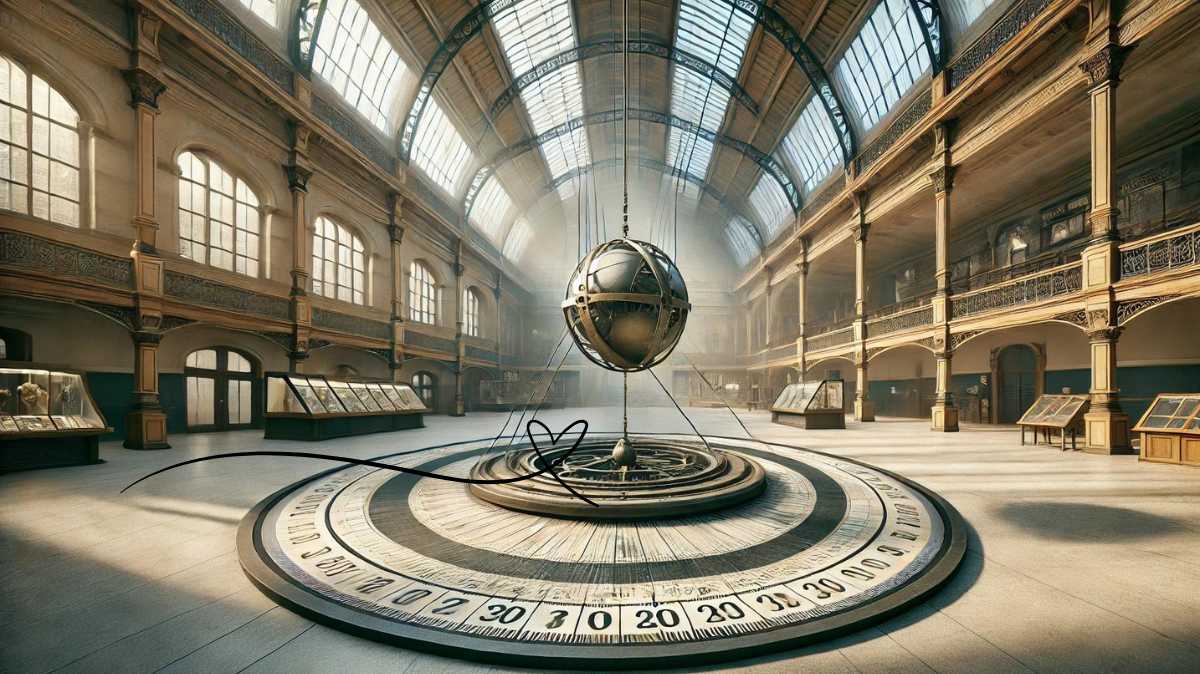The Foucault Pendulum is a remarkable scientific instrument designed to demonstrate the Earth’s rotation. Named after the French physicist Léon Foucault, it offers an elegant and simple method to visually show that the Earth rotates on its axis. Its movement provides an intuitive understanding of a complex astronomical concept—making the invisible rotation of our planet perceptible to the naked eye. The pendulum has become an iconic symbol of science, commonly found in museums and observatories worldwide.
This article will dig deep into the mechanics, history, and significance of the Foucault Pendulum, offering a comprehensive exploration of how it works, its mathematical foundation, and its broader implications in physics and astronomy.
Introduction to the Foucault Pendulum
What is a Foucault Pendulum?
The Foucault Pendulum is a simple yet profound scientific device consisting of a heavy bob, typically a metal sphere, suspended from a long wire. When set into motion, it swings in a plane that appears to slowly rotate over time. In reality, the pendulum is not changing its direction of swing, but the Earth beneath it is rotating. This pendulum is the only instrument capable of directly demonstrating the Earth’s rotation without reference to the sky.
The Foucault Pendulum’s discovery in 1851 by Léon Foucault was groundbreaking because it provided tangible evidence of a phenomenon that had been theoretically understood for centuries but was difficult to observe in practice.
Key Features and Characteristics
- Length of the wire: The length of the pendulum’s wire varies, but longer wires lead to more stable and visible demonstrations of Earth’s rotation.
- Bob weight: A heavier bob helps maintain motion over longer periods.
- Spherical shape: The bob is usually spherical to reduce air resistance and maintain a uniform swing.
- Freedom of motion: The pendulum swings freely in any vertical plane, unaffected by external forces, apart from Earth’s rotation.
The Foucault Pendulum does not change its swing direction relative to the stars; rather, it is the Earth turning underneath the pendulum, which causes this perceived shift.
The Physics Behind the Foucault Pendulum
How It Works
The Foucault Pendulum operates under two main physical forces: gravity, which keeps the pendulum swinging back and forth, and the Coriolis effect, caused by the Earth’s rotation. As the Earth rotates, the pendulum seems to gradually change its plane of motion. At the poles, this rotation is most pronounced, while at the equator, the plane remains relatively stable.
This shift in the plane of motion varies depending on the latitude. At the North and South Poles, the pendulum completes a full 360-degree rotation every 24 hours. At the equator, no apparent shift occurs, and at intermediate latitudes, the rotation takes longer than 24 hours, becoming more gradual as you move toward the equator.
Forces Acting on the Pendulum
- Gravitational Force: The pendulum is pulled downward by the force of gravity, causing it to swing back and forth in a simple harmonic motion.
- Coriolis Effect: Due to the Earth’s rotation, the pendulum’s plane of swing appears to rotate. This is a result of the Coriolis effect, which acts on moving objects in a rotating system.
- Tension in the Wire: The tension in the wire or cord supporting the pendulum ensures that the bob remains in motion without straying from its path.
The motion of a Foucault Pendulum is an application of classical mechanics and is governed by Newton’s laws of motion.
Historical Background of the Foucault Pendulum
Léon Foucault: The Visionary Behind the Invention
Léon Foucault was a French physicist with a keen interest in optics and mechanics. In 1851, he devised the pendulum experiment to provide direct evidence of Earth’s rotation, something that astronomers and physicists had long known theoretically but struggled to demonstrate convincingly. His inspiration for the pendulum experiment came from his earlier experiments involving rotating mirrors.
The first public demonstration of the pendulum was held at the Pantheon in Paris, where a 67-meter-long wire suspended a 28-kilogram brass bob. This demonstration captivated scientists and the general public alike, establishing Foucault as a prominent figure in the field of experimental physics.
Early Experiments and Demonstrations
Before the famous Pantheon experiment, Foucault performed several small-scale trials in his laboratory. His early findings confirmed the gradual shift in the pendulum’s swing plane and led him to refine the apparatus for public display. After the success of the Paris demonstration, Foucault’s pendulum became a popular exhibit in scientific museums, highlighting Earth’s rotation in a way that people could visually grasp.
Practical Applications of the Foucault Pendulum
Educational Tools
Foucault Pendulums are now popular in educational institutions, museums, and planetariums worldwide. They serve as engaging and visually impactful tools for teaching both basic physics and complex concepts like the Earth’s rotation and the Coriolis effect.
The Mathematical Framework of the Foucault Pendulum
The Coriolis Effect
One of the most critical aspects of understanding the Foucault Pendulum lies in the Coriolis effect. The Coriolis effect is the apparent deflection of moving objects relative to a rotating frame of reference—like the Earth. In simpler terms, this effect makes objects traveling long distances across the surface of the Earth appear to curve, rather than travel in a straight line.
For the Foucault Pendulum, this means that the path of the pendulum seems to rotate gradually over time as the Earth rotates underneath it. The amount of rotation observed in the pendulum’s plane is directly proportional to the sine of the latitude where the pendulum is located.
- At the poles: The pendulum’s plane of swing rotates 360 degrees every 24 hours.
- At the equator: There is no apparent rotation, as the Coriolis effect is zero at this latitude.
- At mid-latitudes: The pendulum’s swing rotates, but more slowly. For example, at 45 degrees latitude, it takes approximately 32 hours for a full rotation.
This relationship between latitude and the plane’s rotation speed is a key mathematical concept in understanding the pendulum’s behavior.
The Equation of Motion
The motion of the Foucault Pendulum can be described mathematically by a set of differential equations that account for both the gravitational force acting on the pendulum and the Coriolis effect due to Earth’s rotation.
The motion of the pendulum in a rotating reference frame can be expressed as:

Where:
- θ represents the angular displacement of the pendulum from the vertical axis.
- ω is the angular velocity of the Earth.
- ϕ is the latitude.
The Coriolis force causes a deflection proportional to sin(ϕ), with ϕ representing the latitude. This equation highlights how latitude directly influences the rate of rotation of the pendulum’s plane of swing.
6. Famous Foucault Pendulums Around the World
The Paris Pantheon
The Pantheon in Paris houses the most famous Foucault Pendulum, which was originally displayed in 1851. The original experiment used a 67-meter-long wire and a 28-kilogram brass bob. This demonstration drew international attention and helped to solidify Léon Foucault’s legacy as a pioneering physicist.
This pendulum still swings in the Pantheon today, drawing thousands of visitors who come to witness firsthand the visual proof of Earth’s rotation.
Griffith Observatory, Los Angeles
The Griffith Observatory in Los Angeles, California, features another prominent example of a Foucault Pendulum. Installed in 1935, the pendulum has a 240-pound (about 109 kg) brass sphere suspended from a 40-foot-long wire. It is one of the main attractions at the observatory and serves as an educational tool for visitors.
Other Notable Examples
- The United Nations Headquarters in New York City has a large Foucault Pendulum on permanent display in its lobby.
- The Franklin Institute in Philadelphia also houses a well-known pendulum that has been in continuous operation for decades.
- The National Museum of American History in Washington, D.C., features a large Foucault Pendulum as a key exhibit, illustrating Earth’s rotation for millions of annual visitors.
7. How to Build a Foucault Pendulum
Materials Needed
Building a Foucault Pendulum at home or in a classroom setting can be a fascinating project. To construct a basic version, you will need the following materials:
- A metal or wooden bob (preferably spherical and dense for better momentum).
- A strong wire or cord (the longer, the better; aim for at least 3 meters).
- A sturdy anchor point from which to suspend the pendulum (such as a ceiling beam).
- A support stand or platform if you’re making a smaller model.
Step-by-Step Guide
- Select a location: Find a stable location where the pendulum can swing freely without obstructions. Higher ceilings are preferable for large pendulums.
- Prepare the bob: Attach the metal bob to the wire or cord, ensuring that it is securely fastened.
- Mount the pendulum: Suspend the wire from a fixed point, such as a ceiling beam or a secure frame.
- Set the pendulum in motion: Gently pull the bob back and release it to begin swinging. Be sure to release it without adding any sideways forces that could cause the pendulum to wobble.
- Observe the motion: Over time, the plane of the pendulum’s swing will appear to rotate, demonstrating the Earth’s rotation.
8. The Symbolic and Philosophical Importance of the Foucault Pendulum
Representation in Art and Culture
The Foucault Pendulum has inspired not just scientists but also artists, philosophers, and writers. The device symbolizes the intersection of science and aesthetics, with its simple yet profound demonstration of natural laws.
In literature, Umberto Eco famously used the Foucault Pendulum as a central metaphor in his novel Foucault’s Pendulum, where it represents the pursuit of hidden knowledge and the cosmic dance of order and chaos.
Influence on Modern Physics
The pendulum also holds significance in modern physics, as it offers an early and intuitive example of how rotational motion can affect a moving object. The study of the Coriolis effect and the Foucault Pendulum’s motion has applications in understanding planetary dynamics, weather patterns, and even large-scale ocean currents.
9. Common Misconceptions About the Foucault Pendulum
Popular Myths Debunked
One common misconception is that the Foucault Pendulum always swings in a perfect circle. In reality, the pendulum swings in a plane, and the apparent rotation of this plane is due to Earth’s rotation beneath it. The path of the pendulum is typically an elliptical arc rather than a circular one, depending on the length of the suspension and the initial push.
Addressing Confusion Around Its Operation
Another misconception is that the Foucault Pendulum proves Earth’s rotation by curving its trajectory. The pendulum actually swings in a straight line; it’s the Earth that rotates beneath the pendulum, creating the illusion of a curve.
10. Foucault Pendulum FAQs
Is the Foucault Pendulum affected by local gravity?
Yes, local gravitational variations can influence the pendulum’s behavior, particularly its period of oscillation. However, these variations do not affect the overall demonstration of Earth’s rotation.
Does the pendulum always move in a circular motion?
No, the Foucault Pendulum swings in a straight line, but the Earth’s rotation causes the plane of its motion to rotate gradually, which can give the appearance of circular motion over time.
How does the pendulum demonstrate the Earth’s rotation?
The pendulum’s swing stays constant relative to the stars, while the Earth rotates underneath it. This creates the visual effect of the pendulum’s plane shifting.
What happens at the poles?
At the poles, the plane of the pendulum’s swing rotates a full 360 degrees every 24 hours, perfectly matching Earth’s rotation.
Can the Foucault Pendulum prove Earth’s rotation?
Yes, the Foucault Pendulum provides direct, observable proof of Earth’s rotation, a fact that has been experimentally verified for over 150 years.
How long can a Foucault Pendulum swing continuously?
With minimal air resistance and friction, a properly designed Foucault Pendulum can swing for several hours or even days. In controlled environments, such as vacuum chambers, it could swing indefinitely.
Conclusion
The Foucault Pendulum remains one of the most elegant experiments in the history of science, providing a direct and intuitive demonstration of Earth’s rotation. Whether you encounter it in a museum, build one yourself, or study its principles, this pendulum offers a fascinating glimpse into the forces that govern our planet’s movements. Its impact on both science and culture is profound, symbolizing the human quest to understand the mechanics of the cosmos.
Author

An aspiring business leader, I am working towards my dream of graduating from Stanford University with a degree in Business Management. Passionate about sharing knowledge, I strive to empower others through education and collaborative learning.
View all posts


